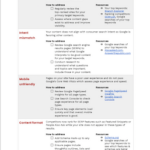Addressing SEO problems can feel like a puzzle. A huge puzzle. A huge puzzle of an abstract landscape with no discerning features. But hey, all puzzles can be solved.
Today, we’re going to dive into the first piece of the puzzle: declining search visibility. In other words, you’re seeing drops in rank and traffic — and you want to know why it’s happening and how to fix it.
What is search visibility?
Search visibility, or SEO visibility, is the share of traffic that a given website receives based on its rankings in organic search.
Overall, both rank and traffic indicate how many people are seeing your content and how much of your target audience you’re capturing — what’s your impression share? How much of that marketplace and search landscape are you actually capturing? And how much of that traffic are you getting? That’s your search visibility.
Why is my website traffic — and my Google ranking — dropping?
You know rank and traffic are important, so you’ve been paying attention to these metrics for your website. You may have noticed that your Google rankings dropped and/or your organic traffic has declined on a month-over-month or year-over-year basis. You may have not made any big changes to your website, so you’re not sure why things are getting worse when all you’re doing is making some small refinements (or even trying to make things better).
Many factors contribute to search visibility, but we’ve narrowed down a list of possible culprits that you should consider if you’re experiencing a drop in traffic and rankings. Let’s get into it.
Infographic
Cause #1: Seasonality
Seasonality is when your business ebbs and flows at certain times of the year due to external, seasonal factors, such as holidays, back to school, etc. Of course, we don’t have any control over when consumers want or need a particular product. That being said, you do have control over your response to that seasonality.
One way to work around seasonality is to create a strong library of evergreen content that supports topics that have year-round demand. Get creative — think about topics that could be applicable for searches year-round.
When it comes to seasonal content, you need to get it rolling well ahead of time. It takes time to build authority in the SERP — that might mean several months before you start to see that traction build. So it’s important to get a head start on publishing that content, linking to it, distributing it — doing everything you can to bolster its performance.
Check out this snapshot from Google Trends. In this example, if you’re a business that sells backpacks, related content should be created well in advance of July–August timeframe for optimal preparedness.
For evergreen content, try to think about the demand for backpacks outside of back-to-school — backpacks certainly have other purposes. That could be something like commuting, travel, or hiking — topics with a little bit more longevity that you could leverage year-round.
Cause #2: A one-off event saw a spike (and subsequent drop)
The next possible cause of declining search visibility would be a one-off event. Maybe you had a large sale or a promotion. Perhaps your business was featured on TV and a prominent media outlet. Maybe you had a new product release. All of these events tend to result in spikes in traffic to your website.
So what can you do to capitalize on this? Take a look at the data and customer feedback from the event — is there anything that you can capture from it that could be translated into evergreen content, or even design or experience enhancements on your website?
A great example of this comes from one of our very own clients. Bobo’s had a feature for one of their oat bars on the Today Show. What they did after the initial buzz had quieted was create an evergreen news page on their site to showcase the feature.
In addition to including the feature on their website, they also thought about creative ways that they could use it in other channels. They decided to promote their peanut butter oat bars — which were the featured product — via their email campaigns and on social media. They did a great job of leveraging that feature to bump up their longevity and authority around that press coverage. Well done, Bobo’s!
Cause #3: Competition is stiff
New competitors have entered the market. Old rivals have upped the ante on their SEO strategy. All of a sudden, they’re leaving you in the dust.
Regularly reviewing the top-ranked site sites for your primary target keywords is a great way to stay on the pulse. See who’s dominating the first page of search results, and take a look at what type of content is ranking. Ask yourself: are we addressing these topics on our site? Are we creating content in the ideal format? And are we doing it better than our competitors?
Cause #4: A case of content mismatch
In that same vein is a content mismatch. Content mismatch is when your content doesn’t align with consumer search intent, so Google is favoring other content. The mistake here that we see often is that businesses get caught up in keyword-focused content.
Of course, keywords are incredibly important. It’s crucial to define your target keywords and assess what the search demand is for those keywords. But really, the first thing that you should be doing when it comes to content is addressing consumer intent.
When you’re creating content, think of the consumer first, and SEO second. I know it sounds counterintuitive, but that’s actually what Google prefers. As you’re creating content, you want to make sure that you’re addressing consumer pain points, addressing common questions, and serving up the type of content that will help them the most — instead of getting too caught up in keyword density.
Doing this requires a thorough understanding of your target audience. What are their interests? What products are they searching for? How are they searching for competitors, similar products? And what questions might they have around that?
Determining consumer intent is a far easier process than establishing buyer personas. Just a simple manual search can provide so much insight into what Google considers “helpful content” and better inform your content strategy. In this example, we searched for the term “dining table.” You can see how insightful the search results page is — there are buying guides that have specific questions called out, “best of” lists, another buying guide…. What we can learn is that the best way to rank for “dining table” would be with a buying guide, list, or comparison-type content.
Let the search results inform and inspire you. Brainstorm ways you can create content in a similar format that does an even better job of answering consumer questions.
Cause #5: Your site isn’t mobile-friendly
Another possible cause of declining search visibility could be that your site is not mobile-friendly. This one’s a little bit more technical, but technical SEO is very important — especially when it comes to mobile usability and page experience.
First, think about the experience a mobile user might have on your website: are the buttons large enough to be tapped on a phone screen? Is your value proposition above the fold? Is the page responsive?
You also want to consider Core Web Vitals (CWV), a series of metrics that assess your overall page experience and speed. CWV is an SEO ranking factor — it’s part of Google’s algorithm.
There are free tools you can use to check on your CWV: Google PageSpeed Insights and Google Search Console. Check your homepage, but be sure to check other page types. A lot of the information you’ll get from these tools is pretty nitty gritty, but your dev teams will understand what to do with it.
Cause #6: You aren’t targeting SERP features
You’re a Google user, right? So you’ve seen search engine results page (SERP) features such as featured snippets, rich results, and People Also Ask questions.
Perhaps your website was ranking for a certain feature and your position got snatched up by a competitor, or maybe you never were — but regardless of the past, you’re not showing up now. Featured snippets capture a ton of SERP real estate, so you must be taking measures on your site to do your best to be shown in a SERP feature.
There’s no guaranteed way to snag those results, but there are steps you can take to increase your chances. The first is Schema: a type of structured data markup that you add within the HTML code that just helps to call out specific content inclusions.
Recipe schema is a common example. You’ve probably seen a recipe card in search results where it will call out the cooking time, the yield, and things like that. Those little snippets of information are marked up with code to give search engines — and users — a better understanding of the content. Other types of schema markup include:
- Products
- Events
- People
- Articles
Let’s look back at the search results for “dining table.” This specific example of a rich result is one of the buying guides that we saw; under “dimensions,” you can see Bassett Furniture is ranking for table dimensions. And look — they’re using Schema! The best part: it’s easy to create and implement the code you need.
There are some other, less technical things that you can do as well. Having a thoughtful heading structure that distinctly defines the sections of your page (using an H1, H2s, H3s, etc.) is highly important for rankings and things like featured snippets and other rich results.
Cause #7: You were penalized by Google algorithm updates
Google loves to keep us on our toes. Algorithm updates can tend to cause shake-ups within the search landscape — including traffic and ranking drops. In fact, just recently, there were multiple algorithm updates that left many websites wondering, “What happened?”
As you look at your traffic and ranking metrics, review the components and the timing of recent algorithm updates. Then, investigate whether or not your site is violating any of the inclusions.
Above all, focus on quality, targeted content. Google’s algorithm updates, especially as of late, put an emphasis on quality content. For example, the most recent: the Helpful Content Update. Google is continuing to reinforce that they value and favor content that is consumer-centric, and that they’re going to devalue content that is clearly intended for SEO or search engines only.

Search Visibility: Causes & Solutions Checklist
Ready to start working through the possible causes listed above? Download our checklist to keep yourself on-task. Each potential cause is paired with links to the tools we leverage when investigating and improving websites to address each cause.
Improve your search visibility with a comprehensive content strategy
There are myriad ways to address declining search visibility and improve your organic traffic — but it may feel like a daunting task when you’ve got a to-do list that looks more like a novel. Two Octobers can help. Contact us today to learn more about how our services can elevate your content.
This blog post was informed and inspired by our webinar, Declining Traffic, Rankings & Conversions: How to Solve the Top 3 SEO Problems.




